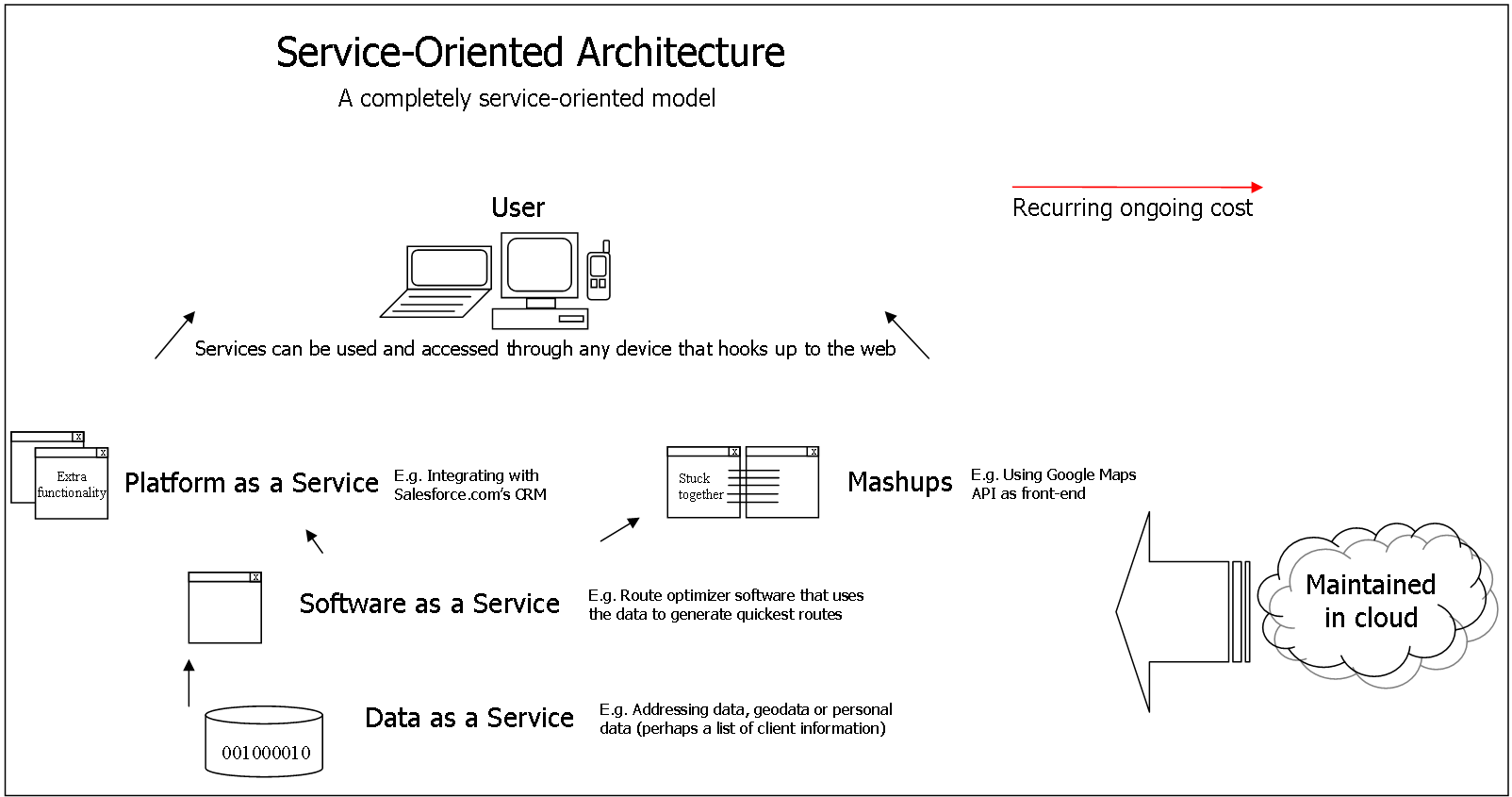In this post, you will read and learn about the top 9 key enabling Technologies in Cloud Computing.
The quickly developing cloud computing sector has changed how companies and people access and use technology. Fundamentally, cloud computing provides software, processing, and storage services over the internet. Grid computing, Virtualization, containerization, and orchestration are critical enabling technologies in cloud computing.
Recommended reading:
Service Oriented Architecture:

Service Oriented Architecture (SOA) is a fundamental part of cloud computing, enabling the modular connection of various services and applications. Through SOA’s reusable components, businesses can easily create new software systems that are highly flexible and scalable – reducing risk in system updates while providing great agility. Divided concerns among services offer immense advantages; organizations now have the capability to add or modify separate pieces without compromising an entire system.
Benefits of service oriented architecture:
Service oriented architecture unlocks immense potential for businesses. By integrating services and applications from multiple vendors, it enables the rapid onboarding of new solutions without disruption to existing operations – turning scalability into a competitive advantage. With SOA, you can also replicate particular components rapidly; ideal when looking towards cloud computing with its stringent resource utilization requirements.
Service Oriented Architecture is key to developing highly efficient applications. By breaking programs into smaller, modularized services, SOA enables the replication and distribution of processes over multiple networks and computers – providing an enhanced level of robustness as well as improved service management capabilities by granularly isolating issues.
Service Oriented Architecture (SOA) introduces a heightened level of security to applications, providing extensive protection against online threats and unauthorized access. Its shield like measures consist of deploying firewalls in tandem with strong encryption at the service-level which ensures safe data transmission between services.
Service Oriented Architecture revolutionizes cloud computing by providing a modular and flexible way to access applications and services. This allows companies more freedom when customizing their digital infrastructure needs.
Grid Computing:

Distributed computing is a cornerstone technology that drives cloud computing. By leveraging the computational capabilities of multiple machines across various networks and locations, we can effectively utilize our resources – an essential factor in making cloud solutions possible.
Grid computing provides a powerful solution to complex data processing needs by distributing computation jobs and increasing speed, while simultaneously allowing for the dynamic allocation of resources. This ensures that the exact amount of computational power is available as needed – enabling smooth adaptation to fluctuating load levels quickly and easily.
Virtualization:

Virtualization is a key technology required to make cloud computing systems come alive, allowing multiple virtual servers to share the resources of just one physical server. This process ensures efficient utilization and greater flexibility when scaling up or down – perfect for growing businesses without limited hardware restrictions!
Furthermore, it simplifies any future maintenance tasks by segregating issues in their own environment thus avoiding disruption across other programs on the same machine. Without Virtualization modern day clouds would not exist; an essential piece of puzzle that drives optimized resource sharing alongside infrastructure scalability within robust IT environments today.
Networking:

Cloud computing relies on robust networking to connect users and ensure they have reliable access to their cloud resources. With the ability to transfer large amounts of data, high levels of reliability, and guaranteed availability – fast networks such as internet are essential for organizations that rely on mission-critical applications, including financial institutions and healthcare providers.
Cloud computing relies on highly secure computer networks in order to protect against any malicious intrusion. Utilizing technologies such as encryption, firewalls and other safeguards are essential steps towards ensuring data is kept safe from prying eyes while keeping the cloud environment impenetrable.
Storage:

Businesses can now access a range of tailored cloud storage solutions based on their demands. Through file, object, or block storage options – each offering distinct advantages for different applications and workloads – organizations can select the service that best fits their individual needs.
With the evolution of technology, more powerful file storage solutions are available to meet the demand for shareable, easily accessible data. Object storage enables a user-friendly experience when storing and managing files such as documents, spreadsheets or pictures – ensuring efficient backup processes across multiple platforms.
Object storage enables companies to store countless amounts of unstructured data in a highly resilient digital format, from pictures and videos all the way up to audio files. Highly scalable and reliable enough for lengthy archival periods as well as backups, object storage is becoming increasingly popular for its ability to accommodate vast stores of seldom-used information.
Block-level storage offers an innovative solution for data access and manipulation. By storing small, individual chunks of information it can provide unprecedented performance capabilities suitable for big data analytics projects and high-performance computing tasks like databases. Block storage is a truly revolutionary way to manage your significant volumes of digital assets!
As cloud storage technology progresses, organizations now have the opportunity to select customized options best-suited for their specific workloads and applications. These specialized solutions range from Cold Storage to Big Data Storage, creating a wealth of choices in terms of suitable providers and services.
Are you interested in discovering the storage capabilities of AWS? Explore its wide range of services and get ready to unlock powerful capacity solutions! AWS storage services.
Automation:

Cloud computing systems facilitate dynamic scalability through automated resource management and provisioning, allowing users to quickly adapt their capacity depending on needs without any manual effort. Automation also facilitates the cloud’s ability to deliver resources in an efficient manner according to varying demand levels – ensuring reliable access regardless of changes.
Containerization and Orchestration:
Containerization and orchestration are powerful cloud technologies that make it easy to quickly deploy and run software packages in multiple environments. Containers provide portability by creating lightweight, self-contained applications that can be effortlessly distributed across different systems.

Orchestration is a powerful technology that allows cloud computing to handle complex applications with ease. It enables the automation of containerized application deployment, scaling and management for maximum efficiency. This remarkable capability makes it an invaluable tool in today’s digital landscape.
Monitoring and management:
Cloud services present an opportunity to keep cloud resources running like a well-oiled machine – users can monitor performance, ensure accessibility and troubleshoot issues on the fly. Now’s your chance to take control of vital tech operations!
Security:

With cyber threats such as data breaches and malware attacks on the rise, organizations must prioritize protecting their valuable cloud-stored assets. Fortunately, leading cloud providers supply a selection of advanced security measures to ensure safety; these include encryption technology for data privacy, authentication protocols enforcing restricted user access levels, and controls allowing administrators to monitor system activity across all environments.
APIs:

Cloud computing makes it possible for developers to drive powerful applications and businesses, by tapping into the scalability of cloud resources through APIs. By leveraging such capabilities via programming interfaces, organizations are able to effectively bridge their local systems with those in the cloud – optimizing flexibility while also promoting efficiency.
Conclusion
As we arrive at the end of this exploration, it is evident that a suite of cloud-enabling technologies are essential to achieve optimal performance. These include grid computing, virtualization and containerization for resource optimization; orchestration tools such as APIs and automation frameworks providing integration across deployments; networking protocols ensuring secure access from any location globally; storage solutions efficiently managing growing data assets with redundancy measures built in; monitoring & management components keeping critical services running reliably 24/7 without interruption or downtime issues caused by hardware failures or malicious attacks which security strategies must be established and enforced protect against threats constantly evolving in today’s digital landscape.
With the advent of cutting-edge technologies, businesses and individuals can leverage technology to its fullest potential – unlocking opportunities for new and creative ways to use computing services.
Cloud technology is a must for businesses today, allowing them to remain agile and take advantage of changing opportunities. These critical enabling tools are key drivers in the development and expansion of this rapidly growing field, providing scalability and flexibility so organizations can thrive as their needs evolve.

